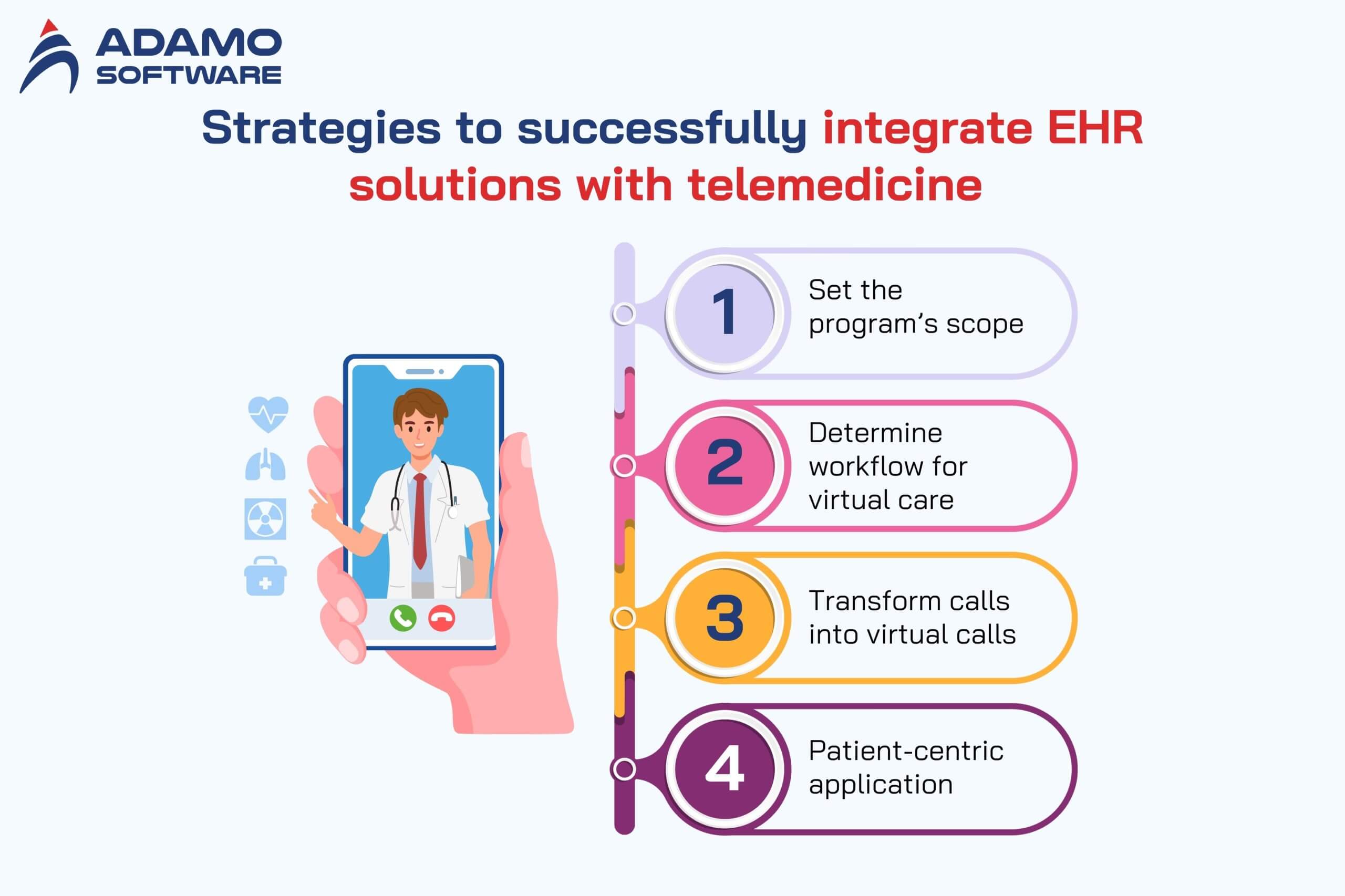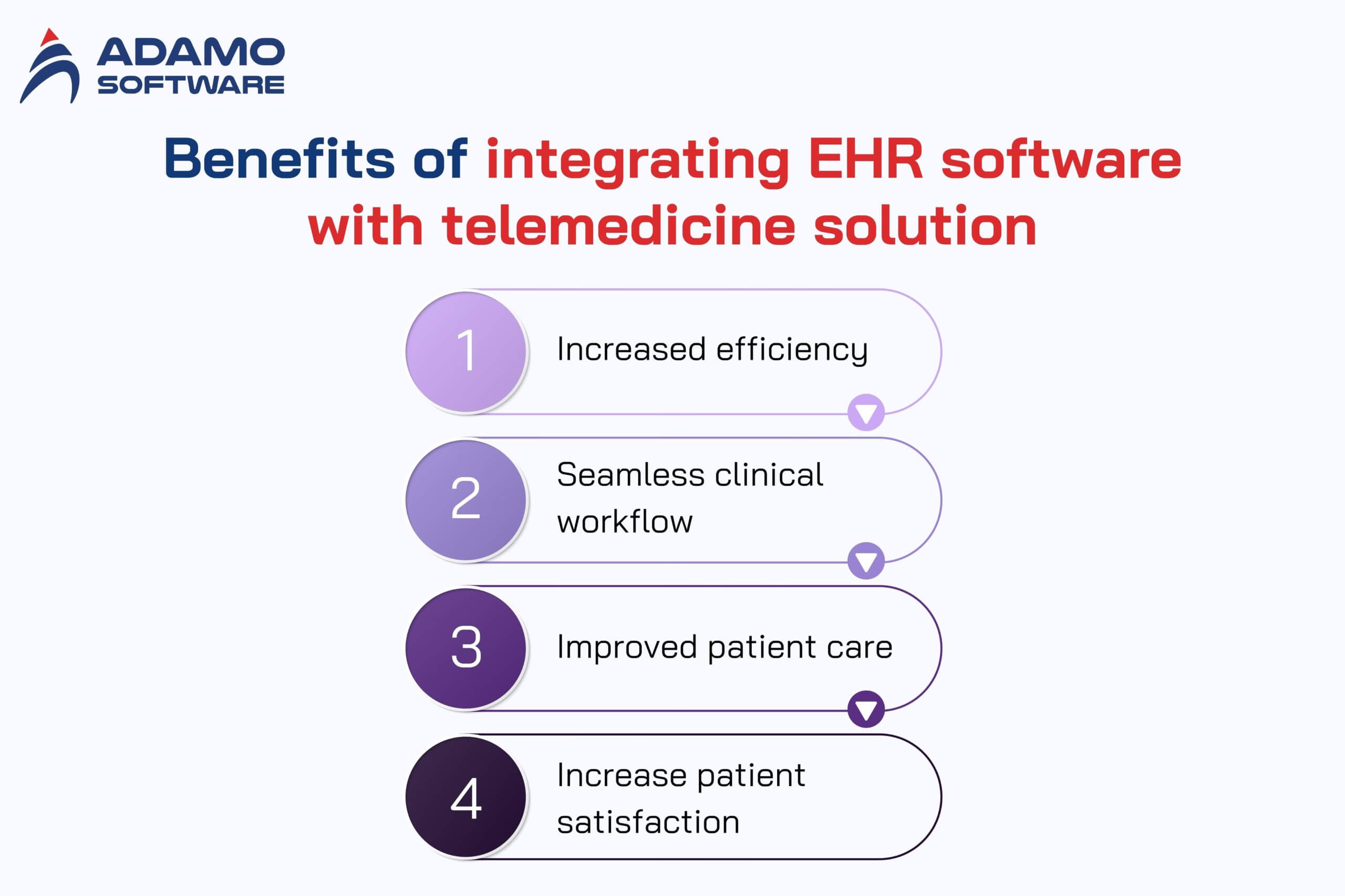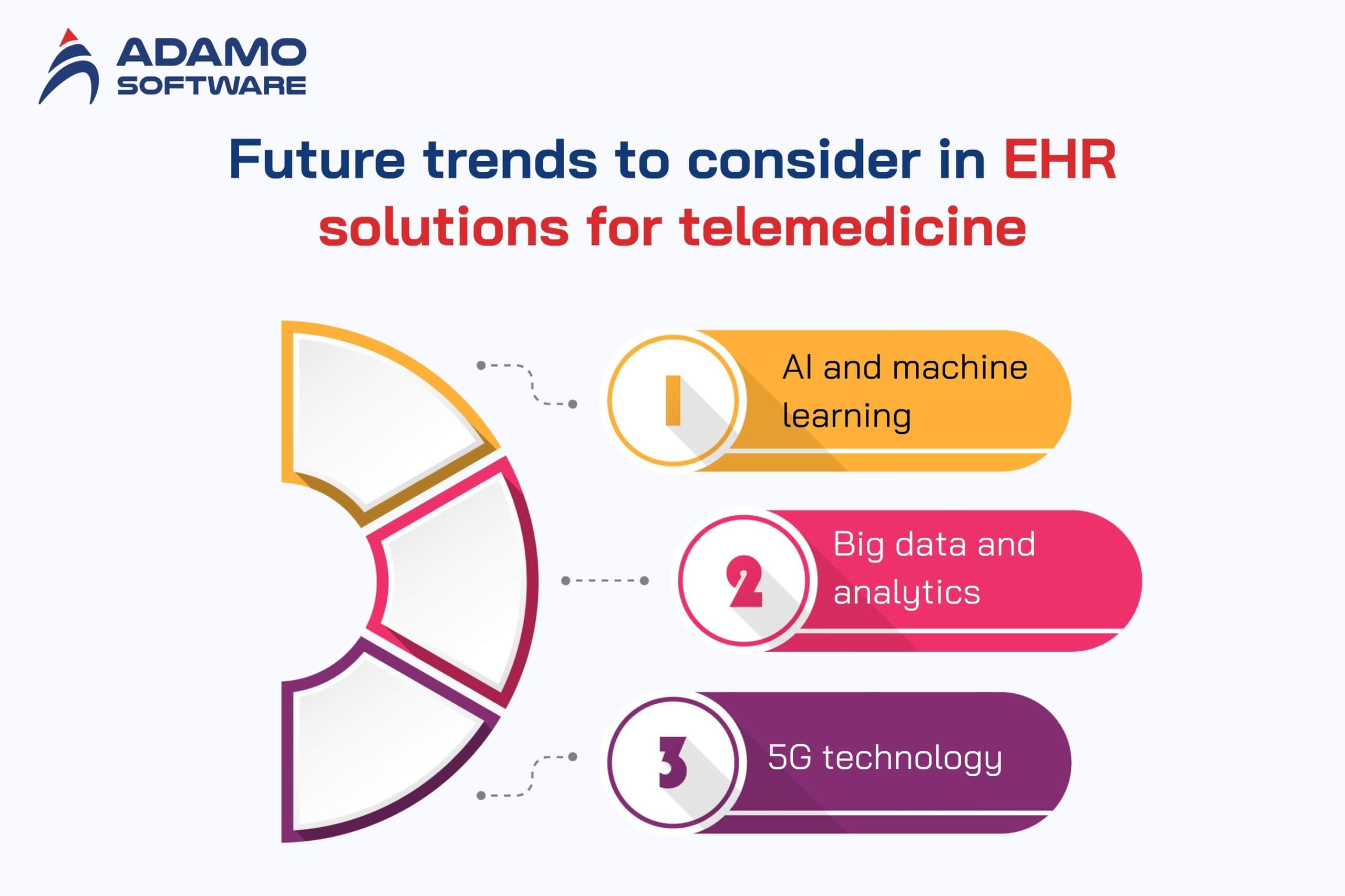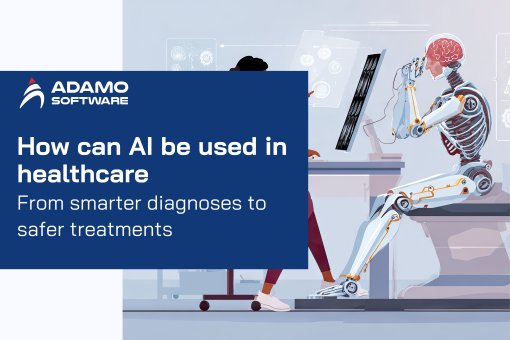EHR solution for telemedicine: A comprehensive guide for starters

The need to integrate technology into healthcare delivery has become inevitable in today’s fast changing healthcare sector to provide effective and efficient patient care. One of the most important advancements in this domain is EHR solution for telemedicine. This is a novel combination of the EHR with telemedicine protocols. This means healthcare providers are able to use telemedicine to communicate with patients without losing sight of the patient’s full data.
When starting with telemedicine, it is important to understand how to effectively implement an EHR solution for telemedicine. This article will be a comprehensive guide for those new to telemedicine EHR systems.
This blog explores the strategies for effective telemedicine implementation. We will show you some of the benefits of EHR solutions, such as improved patient engagement. We will also talk about the main features which make these solutions imperative for the healthcare industry.
Next, we delve into what is happening in the future that’s transforming telehealth. This guide will help you give your patients the best care when improving your practice using an EHR solution for telemedicine.
I. EHR solution for telemedicine: Understand the definition
1. What is EHR?
An electronic health record (EHR) serves as a digital representation of an individual’s medical information. It’s stored electronically. It includes vital details such as medical history, diagnoses, medications, allergies, immunization records, and lab test results. An EHR solution for telemedicine allows healthcare providers to access and manage that information. This helps them see the entire patient’s picture over time.
2. What is telemedicine?
This is the practice of providing healthcare services remotely using telecommunications technology. Features like video calls, phone calls, or secure messaging let patients speak to doctors, nurses, and therapists. With this method, medical consultations and treatments can be done without an in-person visit to healthcare facilities. The EHR solution for telemedicine helps ease this process as it effectively allows the patient records to be within reach during virtual visits.
3. The concept of telemedicine EHR integration
The idea of integrating telemedicine with electronic health record (EHR) systems involves combining telehealth platforms with current EHR frameworks. Telehealth is a term that describes healthcare services that use technology to deliver them remotely. It allows patients to have medical care from home. The EHR solution for telemedicine also enables healthcare providers to access patient information in real time during virtual consultations.
Integrating telehealth platforms with EHR systems allows for accuracy and efficiency in diagnoses and offers advantages in treatment plans. With this integration, information flows smoothly between telehealth platforms and EHR systems. As soon as a telehealth session begins, patient data, such as medical history and allergies, can be automatically drawn from the EHR system.
By integrating these systems, manual data entry is eliminated; thus, there are less errors and improved care quality. In addition, it allows patients and healthcare providers to exchange information in a secure way. An encryption and data protection feature prevents medical information from being seen and preserves patient confidentiality.
II. Strategies to successfully integrate EHR solutions with telemedicine
If you wish to integrate an EHR solution for telemedicine into your practice, then careful planning and preparation are needed to make the implementation successful. A thought-out strategy can make the transition easy and improve the quality of care provided. Here are some key steps to consider:

1. Set the program’s scope
Start by determining which virtual services you want to offer and how you will provide them. Some medical needs to be done in person, so that’s something to know. Healthcare providers can use a scheduling system to permit patients to book their own appointments. This feature aids in the more efficient management of appointments and allows patients to see their doctors more easily as needed.
Furthermore, you should also find out the type of telemedicine services that fit your practice. For example, virtual routine checkups, virtual follow-up consultations, and virtual mental health services can often be provided. This step helps you clearly understand the scope of your EHR solution for telemedicine, so you can tailor it to specific patient needs.
2. Determine the workflow for virtual care
Any digital health platform needs organized workflows to deal with virtual care. These workflows explain the way that healthcare providers can effectively and efficiently use virtual appointments and treatments. By setting these routines, they’ll be able to fulfill the task of consistent patient care and maintaining confidentiality.
Protocols for patient intake, details about patient in-flow and out, and procedures for follow-up should be detailed in the workflows. Not only does this enhance virtual appointments’ efficiency, but it also guarantees their equal efficacy to in-person visits. Also, workflows are well-defined, and managing time becomes more efficient, and therefore, care quality is also improved.
3. Transform calls into virtual calls
Virtual calls or video consultations are ideal for health workers to see patients quickly in urgent situations instead of traditional phone calls. Virtual visits let providers effectively communicate with patients and address their needs.
This becomes extremely useful in visual assessment, such as dermatology or mental health consultations. An EHR solution for telemedicine that supports video calls enables healthcare providers to maintain high care standards in these new, constantly changing circumstances.
4. Patient-centric application
Empowering patients with their health information and access to it will enhance engagement and satisfaction. You may also want to offer a patient portal or mobile application through which patients can look at their health information. This portal gives patients access to diagnostic test results, online bookings, and educational materials on patients’ health conditions.
With the EHR solution for telemedicine, medical staff will find patient care improved and administrative tasks simpler. Additionally, the collaborative environment fostered will result in better health outcomes because it allows patients to manage their health actively.
Also read: Telemedicine App Development Solutions: Key steps to develop
III. Benefits of integrating EHR software with telemedicine solution
Integrating an EHR solution for telemedicine has delivered numerous enhancements to healthcare delivery and patient experiences. Not only does this help to move processes along, but it also improves the quality of care provided. Here are some key benefits:

1. Increased Efficiency
Deploying the EHR solution for telemedicine greatly reduces the amount of manual data transfer. It ensures a seamless connection to allow healthcare providers to have immediate access to the patient data during virtual consultation, facilitating faster decision-making.
Reducing administrative burdens should relieve healthcare professionals of the burden of data entry and paperwork, allowing them to focus wholly on direct patient care. Such efficiency is especially critical in today’s frenetic medical world. Indeed, identifying ways to process increasing patient caseloads and complex cases is an ongoing challenge.
In addition, data transfer takes less time and is more accurate, resulting in fewer errors than might be caused by manual processes. This achievement represents a giant stride taken in modern healthcare practice in the best way to deliver quality care to everyone.
2. Seamless clinical workflow
The usage of the EHR solution for telemedicine results in the integration of workflow and the quality of the patient’s clinical process. With virtual visits, patient data is automatically retrieved from the EHR system and made available to the health care provider at any other time.
This capability facilitates informed consultations and makes it easier for the documentation processes. Ideally, it will create a more structured approach to virtual care. With such a system, healthcare professionals can easily access medical histories, medication lists, and test results without interruption.
Ultimately, it makes decision-making more appropriate during consultation. Additionally, this simplified workflow makes virtual appointments more efficient. It focuses on patient needs instead of a clinical checklist of questions.
3. Improved patient care
Integrating telecommunication equipment with interoperable EHR systems in telemedicine provides an enhanced quality of care provision at telehealth consultations. Having wide and complete patient information automatically allows healthcare providers to come up with better decisions on diagnosis and treatment plans.
Due to the access to full data, approaches tailored to an individual patient’s needs will ultimately improve health outcomes. Besides that, telehealth service integration allows for continuous tracking of patients’ conditions.
Because patients are constantly monitored, it is possible to intervene in time when needed. Being proactive is especially useful for managing chronic conditions. If healthcare providers catch that change in a patient’s health status early, they can respond sooner. Integrating EHR and telemedicine creates a holistic care environment for patients, providing timely and proper medical attention.
4. Increase patient satisfaction
The EHR solution for telemedicine can greatly improve the overall patient experience and satisfaction levels. This is possible thanks to easy access to medical records when it comes to virtual visits. Patients like having their health information ready during the visit so that they can communicate better with their healthcare providers.
Transparency allows the patient to be proactive in the care discussion, patient decision, and appropriate access to care they need. Telemedicine also increases access to specialty care, particularly for patients in rural or underserved areas who may lack access to healthcare resources.
Additionally, travel barriers and wait time for in-person visits can be reduced, increasing the likelihood of patients visiting a physician when needed. As a result, this increased accessibility leads to greater satisfaction with the overall healthcare system.
When our patients feel cared for and valued and are able to connect easily to their providers, it is a win-win for everyone involved! The result is better patient-provider relationships and better adherence to treatment plans.
IV. Key features of EHR solution for telemedicine
Different EHR systems come with different telemedicine functionalities. Those who are planning to incorporate the EHR solution for telemedicine will require the systems that can help them most effectively. That is, a system that can facilitate virtual care but still has the quality and security of in-person care services. In order to do that, your EHR solution for telemedicine must include these following functions:
1. Telemedicine EHR integration
Providing a unified experience for patients and providers alike is crucial. Consequently, it is essential for the telemedicine software to be seamlessly incorporated into the EHR system designed for telemedicine. With this integration, providers can see patient records, prescribe medications, document care, and look after billing in the same system. This integration ensures that virtual consultations are just as effective as face-to-face appointments.
- Unified platform: Telehealth services combined with traditional healthcare workflows should be provided via a single, fully integrated EHR solution to align telehealth services with traditional workflows.
- Real-time access: During virtual consultations, providers have real-time access to a patient’s complete medical history, enabling informed decision-making and accurate diagnosis.
- EHR-embedded video visits: Video visit capabilities within the EHR solution for telemedicine often integrate telemedicine functionality with provider and patient simplification.
2. HIPAA-compliant telehealth solutions
When delivering care remotely, one of the primary focus areas is patient privacy and data security. A good EHR solution for telemedicine includes HIPAA-compliant telemedicine software. This software should encrypt all communications, patient data, and video conferences to secure sensitive information transactions.
- Secure messaging and video calls: Secure messaging and video calls can occur between patients and providers in the EHR from which privacy regulations are met.
- Protected data exchange: The EHR solution for telemedicine encrypts all the data exchanged during telehealth appointments and keeps it secure from unauthorized access.
3. Telemedicine scheduling and billing integration
Virtual visits should not be any more or less complicated to schedule, coordinate, and bill for than in-person visits. An EHR for telemedicine includes scheduling tools for online appointment booking. It also manages billing and claim filing for telehealth services.
- Automated scheduling: Patients can schedule virtual telemedicine visits through their patient portal and then get automated appointment reminder emails and links to their virtual consultations.
- Telemedicine billing: The EHR solution for telemedicine seamlessly bills out telehealth visits and includes coding to submit billing to insurance, telehealth-specific billing codes, and auto claims.
4. Patient portals and engagement tools
Patient engagement and communication tools for telemedicine mainly rely on a patient’s ability to access their health records and communicate with providers. Additionally, these tools allow patients to manage appointments from any device. A telemedicine EHR solution features comprehensive patient portals that promote greater patient involvement in a virtual care setting.
- Secure patient portal: Authored lab tests, visit notes, medication lists, and other medical histories of patients are available in a secure portal. This allows patients to stay in touch with their care and access their test results.
- Appointment reminders and follow-ups: Because patients need to stay on track with their care plans, automated reminders for upcoming telehealth appointments and follow-up messages help patients.
5. Remote Patient Monitoring (RPM) Integration
Integrating RPM with telemedicine features for patients with chronic conditions or people who need to be routinely monitored is an absolute must. Now, RPM tools have been incorporated into many of the EHR solutions for telemedicine systems. They are used by providers to monitor patient data, like vital signs and glucose levels, in real-time during telehealth consultations.
- Smart device integration: By integrating into smart devices and wearable devices, the RPM-enabled EHR systems automatically send patient data into the EHR for analysis and documentation.
- Proactive care: This enables remote monitoring of the sick patient by a provider and intervening earlier if any concerning trends occur. Ultimately, it helps increase outcomes and decrease the rate of hospitalization.
V. Future trends to consider in EHR solutions for telemedicine
As technology matures, several future telehealth EHR integration trends will likely transform the realm. Together, these trends will dramatically improve the capabilities of healthcare providers as well as the care of patients.

1. AI and machine learning
The EHR solution for telemedicine is expected to largely rely on artificial intelligence and machine learning. Such systems can be automated through these technologies with improved diagnosis accuracy and efficiency. For example, AI algorithms can sort through huge amounts of patient data from EHRs, find patterns, and even predict a health outcome. This AI capability allows healthcare providers to make data-driven decisions, which leads to improved patient care.
Additionally, AI can free humans from the responsibility of coding, billing, or scheduling. These technologies reduce the burdens on healthcare staff, allowing greater care delivery and more interactions and care deliveries with patients. Once the EHR solution for telemedicine has AI, personalized treatment plans for patients will likely be based on patient history and individual responses.
2. Big data and analytics
Telehealth Integration with EHR Integration is going to be driven by big data and analytics. Analysis of large datasets can offer hints about how to classify patient populations. It provides an advantage to proactive interventions and supports evidence-based decision-making.
By analyzing big data, healthcare providers are able to spot patterns in patient health, monitor the results over time, and optimize treatment procedures. Integrating big data with EHR systems can help enrich providers’ understanding of dynamics in population health. Hence, it nurtures the rise to more appropriate public health strategies.
3. 5G technology
Telehealth EHR integration is set for a revolution with 5G technology. A faster and more reliable network will allow real-time patient data transfer. With this improvement, HD video consultations or remote monitoring solutions with minimal latency will be possible.
Besides, better communication between patients and providers can occur due to 5G technology. Thus, healthcare professionals can react as soon as possible to urgent situations and provide high-quality care standards.
VI. Why you should choose Adamo Software as your partner for Telehealth EHR integration

If you are looking to integrate an EHR solution for telemedicine, Adamo Software is your ideal partner. With our expertise, your telehealth platform can seamlessly integrate electronic health records. By tailoring solutions that improve patient care while meeting industry regulatory compliance requirements, we offer turnkey solutions for every step in the process.
Our user-friendly interfaces simplify and help make patient information easy to find. By choosing Adamo Software, you’ll be able to optimize your healthcare solution services and make your entire operations more efficient.
Want to discuss your EHR solution for telemedicine? Contact us today!











